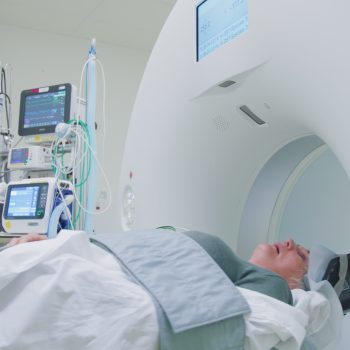April 2, 2024
Stroke care has experienced transformative advances over the past few decades, significantly altering the landscape of diagnosis and treatment. The MR CLEAN trial marked a watershed moment, fundamentally changing the approach to acute stroke intervention and emphasizing the critical importance of timely and accurate diagnosis. This pivotal research underscored the value of rapid, precise imaging in facilitating effective treatment decisions, particularly the use of endovascular thrombectomy in patients with acute ischemic stroke. As we navigate the complexities of modern stroke care, one technological advancement stands out for its impact on improving the efficiency and speed of diagnostics: automatic motion correction.
Understanding the Challenge: Motion Artifacts in Stroke Imaging
Accurate neuroimaging is the cornerstone of stroke diagnosis and treatment planning. However, obtaining clear images can be challenging due to patient motion, which often results in artifacts that compromise the quality of diagnostic scans. Whether involuntary movements from discomfort, agitation, or the clinical condition itself, these artifacts can obscure critical details necessary for diagnosis, potentially delaying or complicating treatment decisions.
The Role of Automatic Motion Correction
Automatic motion correction technology represents a significant leap forward in overcoming these obstacles. By employing sophisticated algorithms to detect and correct for motion artifacts in real-time, this technology ensures that the images produced are as clear and informative as possible. The benefits are manifold:
Enhanced Image Quality: Automatic motion correction delivers sharper images, enabling clinicians to identify and characterize stroke-related abnormalities with greater confidence (Cancelliere et al., 2022). This clarity is crucial for detecting subtle signs of early ischemic changes or small hemorrhages that could influence treatment choices.
Reduced Need for Repeat Scans: By minimizing the impact of motion on image quality, automatic motion correction decreases the likelihood of needing to repeat scans. This not only saves valuable time in emergency settings but also reduces the patient’s exposure to additional radiation and contrast agent, if applicable.
Improved Access to Treatment: Clearer images translate to more accurate diagnoses, which can expand eligibility for critical interventions like thrombolysis and thrombectomy. Patients who might have been considered borderline candidates due to ambiguous imaging findings could benefit from these life-saving treatments.
Enhanced Efficiency in Stroke Care Workflow: Streamlining the diagnostic process with automatic motion correction contributes to a more efficient stroke care workflow. Rapid, accurate imaging facilitates quicker decision-making, enabling healthcare teams to initiate treatment sooner—a key factor in improving patient outcomes.
From Past to Present: The Journey Since the MR CLEAN Trial
Reflecting on the evolution of stroke care since the MR CLEAN trial, the integration of automatic motion correction into stroke diagnostics epitomizes the technological strides made in the field. Prior to such innovations, the limitations of imaging technology often hindered the efficiency and speed of diagnosing and treating strokes. Today, advancements like automatic motion correction embody the relentless pursuit of precision and speed in stroke care, underscoring a commitment to leveraging technology for the benefit of patients worldwide.
Looking Forward with Nicolab’s StrokeViewer
As we embrace the future of stroke diagnostics, Nicolab’s StrokeViewer stands at the forefront of innovation, embodying the advancements that have shaped the field since pivotal moments like the MR CLEAN trial. With features like automatic motion correction, StrokeViewer exemplifies the cutting-edge technology that propels stroke care forward, ensuring healthcare professionals have access to the tools they need for rapid, accurate diagnosis and treatment planning.
In an era where every second counts, technologies that enhance the clarity and reliability of diagnostic imaging are invaluable. StrokeViewer’s integration of automatic motion correction is a testament to Nicolab’s dedication to advancing stroke care, offering a platform that not only meets the challenges of today but also anticipates the needs of tomorrow.
Continue Exploring Innovations in Stroke Care Technology
The journey of stroke care from the days preceding the MR CLEAN trial to the present highlights the critical role of technological innovation in enhancing patient outcomes. As we continue to explore the forefront of stroke diagnostics and treatment, Nicolab invites healthcare professionals to learn more about how tools like StrokeViewer can transform the landscape of stroke care.
Discover the potential of advanced diagnostics and the significance of innovations like automatic motion correction in our ongoing guide on Innovations in Stroke Care Technology. Join us in shaping the future of stroke care, where technology and expertise converge to save lives and improve recovery.
Eager to understand how cloud-based platforms are revolutionizing the way we access critical care, especially in the high-stakes world of stroke treatment? Dive into our comprehensive article, “Cloud-Based Platforms: The New Horizon in Accessing Critical Care” to explore the groundbreaking shift towards more accessible, efficient, and collaborative care pathways enabled by the cloud. This insightful piece offers a window into the future of healthcare, demonstrating how technology is removing barriers and setting new standards for saving lives.
For those intrigued by the intersection of technology and healthcare, and keen to see how Nicolab is at the forefront of these innovations with StrokeViewer, we invite you to schedule a demo. Experience firsthand how StrokeViewer’s cloud-native platform is transforming stroke care, making critical interventions more timely and effective than ever before.
Let StrokeViewer improve your team’s stroke workflow
